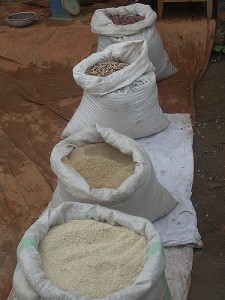A new report commissioned by the Partnership to Cut Hunger and Poverty in Africa aims to inform U.S. policymakers, as they debate the 2012 Farm Bill, of important changes in the policies and practices of U.S. food aid since the 2008 Farm Bill was passed. The largest international food aid program, the Food for Peace Act, is incorporated into the U.S. farm bill process, and the report hopes to encourage further improvements in the effectiveness of food aid. The report was written by former Chief Economist for the Democratic staff on the U.S. Senate Agriculture Committee Stephanie Mercier.

In the report Mercier discusses the use of innovative tools that were first used in the 2008 Farm Bill, which she says improved the efficiency and effectiveness of food aid. These new tools include local and regional procurement of commodities, greater focus on the nutritional qualities of food assistance, stronger ability of non-emergency development aid to address root causes of food insecurity, and better use of information generated by USAID’s Famine Early Warning System Network (FEWSNET). According to the report, however, the effectiveness of food aid funds could benefit from more flexibility and better coordination among new and existing programs, the report says. Mercier emphasizes the growing interest in using development aid money and resources to achieve food security goals.
“Food aid and food security are going to face a lot of challenges in the next couple of years,” Mercier explained at a June 10 event in Washington D.C. Mercier says that the Obama administration’s Feed the Future food security initiative, for example, faces budget pressure from the U.S. House of Representatives, which has been pushing to cut funding for the program significantly. Recent global commodity price volatility has also created challenges for U.S. food aid, as the amount of aid that can be given in the form of in-kind commodities is dependent on relative prices. Finally, the World Trade Organization’s (WTO) Doha Round of international trade negotiations—which could include restrictions on in-kind donations of food commodities and higher requirements for needs assessments in food aid—has made little progress towards completion, creating an environment of uncertainty.
Panel discussant Susan Bradley, Senior Policy Advisor to the U.S. Agency for International Development’s (USAID) Bureau for Food Security, emphasized the importance of improving the effectiveness of food aid. “We have to remind ourselves that when nearly a billion people are going to bed hungry every night, at best in any given year, it’s 100 million, maybe 103 million, that receive food assistance. The rest still go to bed hungry.” Bradley said that one innovation that could improve effectiveness was the practice of transferring cash to aid recipients, instead of food donations, in cases where food is available but unaffordable.
“With roughly $2 billion in funding provided for U.S. food assistance programs in fiscal year 2010,” says the report, “and more than $1 billion provided for development assistance aimed at increasing agricultural productivity in food-deficit countries, the effectiveness of these programs remains an important priority for policymakers and all those concerned with addressing hunger and poverty in the developing world.”

Danielle Nierenberg, an expert on livestock and sustainability, currently serves as Project Director of State of World 2011 for the Worldwatch Institute, a Washington, DC-based environmental think tank. Her knowledge of factory farming and its global spread and sustainable agriculture has been cited widely in the New York Times Magazine, the International Herald Tribune, the Washington Post, and
other publications.
Danielle worked for two years as a Peace Corps volunteer in the Dominican Republic. She is currently traveling across Africa looking at innovations that are working to alleviate hunger and poverty and blogging everyday at Worldwatch Institute’s Nourishing the Planet. She has a regular column with the Mail & Guardian, the Kansas City Star, and the Huffington Post and her writing was been featured in newspapers across Africa including the Cape Town Argus, the Zambia Daily Mail, Coast Week (Kenya), and other African publications. She holds an M.S. in agriculture, food, and environment from Tufts University and a B.A. in environmental policy from Monmouth College.








